Find out what makes Antarctica so special. Learn everything you need to know to plan your trip to the seventh continent of the world, including detailed itinerary, essential tips, cost insights, and unforgettable experiences with this comprehensive Antarctica Travel Guide.
Why visit Antarctica?
After months of exploring the extremes—from Greenland’s glaciers to the Amazon’s jungles—it all came down to this: Antarctica, the most remote, untouched place on Earth. This journey truly represented my final frontier — the last of the seven continents to visit. Visiting Antarctica was like stepping into a living science book—it’s a place that holds 90% of the world’s ice and about 69% of its freshwater. Standing among towering glaciers and massive tabular icebergs, I realized just how crucial this continent is for regulating our planet’s climate and sea levels. Seeing the incredible wildlife, like penguins, seals, and whales, thriving in this extreme environment was awe-inspiring. But what struck me most was learning about how fragile this ecosystem is and how quickly it’s changing. This journey from the Arctic to Antarctica has been a humbling experience, showing me just how much there is to learn—and protect—for future generations. Through this detailed Antarctica Travel Guide, I want to share how this expedition was less about just ticking boxes on a travel list and more about truly immersing myself in some of the world’s most pristine wildernesses. Join me as I reflect on my incredible 11-day Antarctic Expedition with Quark Expeditions and Adventure Life!
To begin with, let’s start with my Antarctica Travel Itinerary:

Day 1 – Arrival in Ushuaia
Day 2 – Embarkation on World Explorer
Day 3 – Facing the Drake Passage Southbound
Day 4 – Entering the Antarctic Peninsula
Day 5 – Cuverville Island and Orne Harbour
Day 6: Danco Island and Paradise Harbour
Day 7: Charlotte Bay and Foyn Harbour
Day 8 – Cierva Cove and Mikkelsen Harbour
Day 9 & 10 – Facing the Drake Passage Northbound
Day 11 – Disembarkation in Ushuaia
In this Antarctica Travel Guide, I’ll share my entire journey from India to Antarctica, unique Antarctica experiences, why I chose to travel with Quark Expeditions and answer some frequently asked questions about travelling to Antarctica.
Travelling to Antarctica from India
Here is a detailed description of my trip to Antarctica from India. Exciting insights await in this Antarctica Travel Guide!
A Long Haul from India: Reaching the Southernmost City
The thrill of embarking on an exciting journey from Delhi to Ushuaia with Ethiopian Airlines wasn’t a bad start, especially since I was headed to the departure point of my dream trip to Antarctica – a journey that I had meticulously planned using a trusted Antarctica travel guide. Despite the long journey and jet lag, the adventure was exhilarating! My overnight flight from Delhi to Ushuaia at 2:50 am on November 13th had a tricky web check-in. Although I had booked a vegetarian meal, it didn’t show up in the airline system during the flight, but the airline staff took great care of me by providing a meal on board. There were no delays, and I reached Buenos Aires on time.
. Despite the long journey and jet lag, the adventure was exhilarating! My overnight flight from Delhi to Ushuaia at 2:50 am on November 13th had a tricky web check-in. Although I had booked a vegetarian meal, it didn’t show up in the airline system during the flight, but the airline staff took great care of me by providing a meal on board. There were no delays, and I reached Buenos Aires on time.
I stayed overnight at Carles Hotel Buenos Aires in Buenos Aires on November 13th. Located in the Retiro district of Buenos Aires, Carles Hotel was perfect for me due to its convenient location, immaculately clean and comfortable room that was tastefully designed, and helpful, friendly staff who ensured I didn’t go hungry despite having an early morning flight.
Day 1- Arriving in Ushuaia
The next day, I took an early morning Aerolineas Argentinas flight from Buenos Aires to Ushuaia. Quark Expeditions staff was waiting for me with my name placard at the airport’s arrival area. I checked in at Albatros Hotel with other fellow travellers on the same expedition. A one-night stay in Ushuaia was included as part of the 11-day Antarctic Adventure. The best part about this hotel was its central location. The food and staff were not bad either.
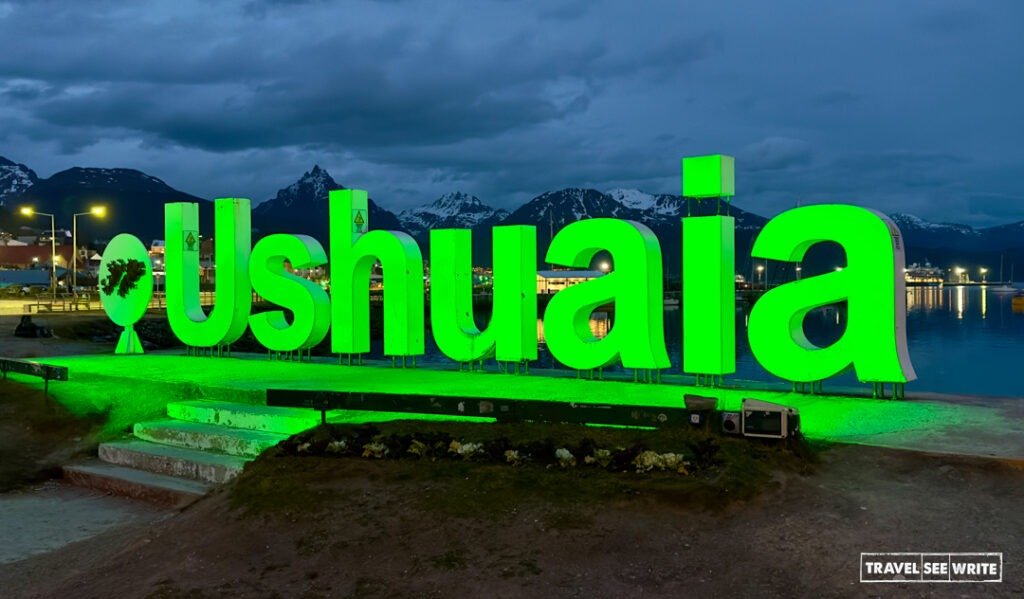
Day 2 – Embarkation on the World Explorer
The next day, November 15th, after breakfast at 9:30 am, I left my tagged luggage at the hotel reception area to be transferred to the ship. After the luggage deposit, I was free to explore Ushuaia, the world’s Southernmost City. I joined another traveller, Bobby from Australia, who was on the same expedition for a Ushuaia City Tour. Despite the rain, we enjoyed beautiful views of the Beagle Channel and rugged mountains during our city tour. The bilingual commentary provided fascinating insights into the city’s history. Overall, it was a memorable experience that showcased the unique charm of Ushuaia, a frontier town with a rich history and a vibrant culture that is sure to intrigue any traveller!
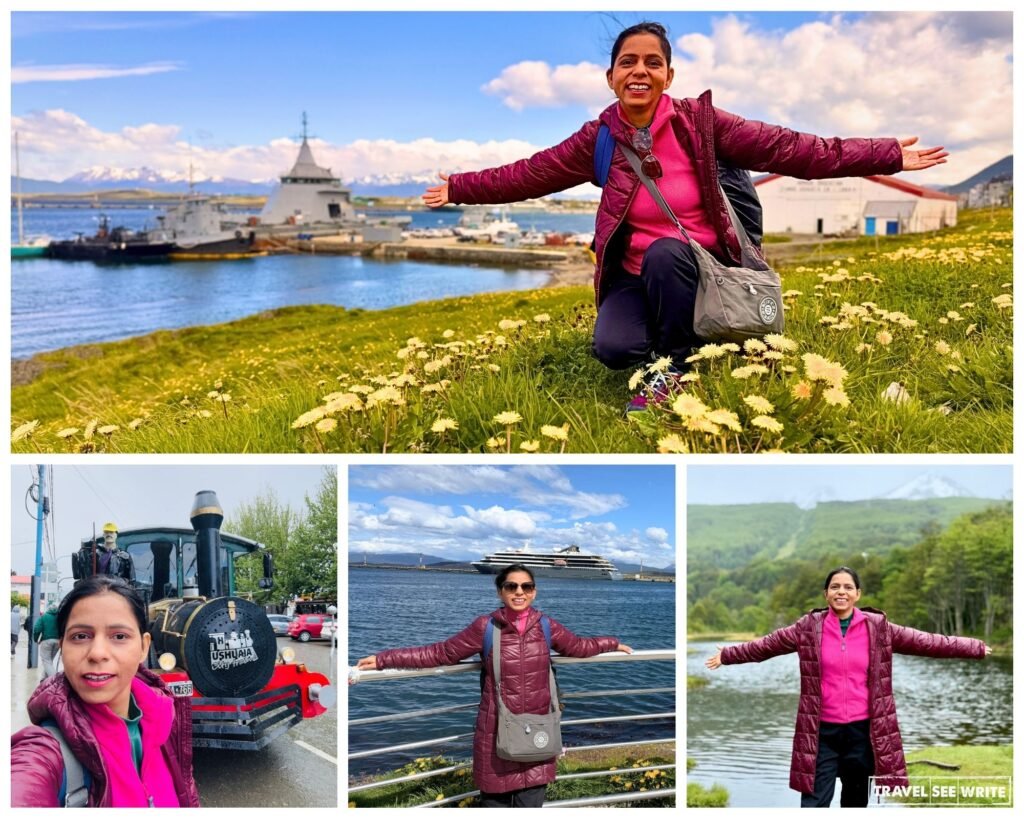
Then, Bobby and I wandered through the charming streets, soaking in the unique atmosphere of this frontier town. We first visited the local tourism office, eager to collect stamps in my passport as a souvenir of my journey. The office was bustling with visitors, and the friendly staff happily assisted me in adding the official stamps to my passport, marking this adventure in a memorable way. We had quite the adventure searching for the ‘End of the World’ sign! We passed it multiple times, but it turned out to be a simple little board. It’s fun how travellers can make even the smallest things seem grand!
Later, at 3:45 pm, we reached the designated Rumbo Sur bus parking lot meeting point, which transported us to the embarkation point of our World Explorer ship, a large ship with eight decks. I presented my passport and booking details and received my room key, which I was required to carry throughout the expedition for disembarkation and embarkation checks. I was super impressed by the facilities on board and my Veranda Suite cabin. My cabin was spacious, well equipped with modern facilities and offered stunning views from a private balcony, enhancing the experience of the icy landscapes. There was a surprise waiting for each of the adventurers in their room – a specially designed bright orange colour Parka Jacket and a reusable water bottle for our Antarctica expedition.
The vessel – World Explorer by Quark Expeditions – was designed for polar exploration and has a cosy capacity of around 180 guests. As I had read in other Antarctica travel guide, this ship was perfectly equipped for a journey to the world’s most extreme continent, with features like vibrant lounges, observation decks, and facilities like an ice-strengthened hull for safe navigation, zodiac shore landings, an interactive science centre, a gift shop, a salon, and a wellness centre. Dining included exquisite meals tailored to dietary needs while prioritising sustainability. It beautifully blended adventure and luxury. At the coffee station, one could get unlimited tea and coffee at any point in time. Both alcoholic and non-alcoholic beverages were free at deck number 4 lounge.
The ship held a Captain’s Welcome Party in the evening, followed by a safety briefing. The briefing included detailed information about the ship’s advanced stabilisers and the experienced crew’s preparedness for the often rough seas. We were also advised to collect any necessary medications from the reception.
In the evening, our vessel sailed down the historic Beagle Channel, which transects the Tierra del Fuego archipelago in the extreme south of South America. As we departed, our Tour leader told us that the next time we see land, we’ll be on the world’s most southern Continent!
Day 3 – Facing the Drake Passage: A Test of Endurance
The next day, November 16th, the Drake Passage certainly made its mark! When I awoke, the gentle sway of our ship had transformed into an adventurous rocking and rolling ride across these legendary waters. The waves crashed and tumbled around us, and I quickly realized this journey would be a true test of my endurance—one I had never expected! Despite the challenges, it became clear that the ocean’s dynamic nature was part of the adventure. However, I found myself needing to retreat to my cosy cabin, where I bravely battled a touch of seasickness.
After a light breakfast, I decided to embrace the comfort of my room instead of heading to the auditorium. Luckily, the Smart HD TV was my gateway to the ship’s exciting happenings, allowing me to catch a fascinating presentation by the talented ornithologist Corey Jones. He introduced us to the stunning “Seabirds of the Southern Ocean.” With every detail he shared, I felt my spirits lift as I thought about the incredible wildlife surrounding us—eleven magnificent bird species, including the Snow and Giant Petrels, danced through my imagination. The beauty of Antarctica kept me motivated, even while I faced my queasy challenges.
Though our plans for the day shifted with the postponement of the Sea Kayak, Paddle Excursion, and Stand-Up Paddle briefings due to the lively seas, I saw this as another chance to rest. I allowed myself to drift into a light sleep, filled with dreams of playful penguins and breathtaking icy landscapes waiting just ahead. The journey might be bumpy, but the thrill of what lay beyond was just too exciting to miss!
Day 4 – Entering the Antarctic Peninsula
The next morning, November 17th, I awoke feeling refreshed and ready to embrace the day. The ship had calmed, and a delicious breakfast buffet beckoned. After fueling up, I joined my fellow adventurers for a series of inspirational talks. One presentation delved into the rich history of Antarctica Expeditions, while another shed light on the various types of icebergs—each more distinct than the last: the flat tops of tabular icebergs, the jagged edges of pinnacle icebergs, and even the curious shapes of dry dock icebergs.
Post-lunch, the excitement mounted as we gathered for the IAATO Landing & Zodiac Briefing, led by Expedition Leaders Shane Evoy and Adrian Boyle. They meticulously explained the zodiac operations and provided essential safety tips for our landings. Later, we were called to the mudroom on deck 3 to complete the Biosecurity checks and boot swap in case our shoe size and Parka size weren’t right.
Divided into four colour-coded groups—Blue, Green, Orange, and Pink— the 157 guests felt the thrill of anticipation build as we readied ourselves for our first encounters with this frozen wonderland.
Day 5 – Cuverville Island and Orne Harbour
Finally, the moment I had been waiting for arrived on November 18th. Our first zodiac landing at Cuverville Island took place against a backdrop of breathtaking scenery. As we disembarked, I was quickly captivated by a large colony of Gentoo penguins. The vibrant pinkish-orange beaks and the charm of their antics kept me entranced. Whether they were waddling, sliding on their bellies, or calling to one another, their energy was infectious. The sheer number of penguins was astonishing, and their playful antics provided endless entertainment. Along with the adorable penguins, we saw southern giant petrels, kelp gulls, Antarctic terns, snowy sheathbills, and skuas. The unique wildlife encounters on Cuverville Island were genuinely fascinating.
In the afternoon, our zodiac cruise at Orne Harbour revealed more delights—a curious Leopard Seal pup and a bustling Chinstrap penguin colony greeted us. The only sounds we heard were the gentle lapping of the water and the occasional splashes as penguins dove into the frigid sea.
Day 6 – Danco Island and Paradise Harbour
On November 19th, I stood in awe as we landed on Danco Island, known for its stunning scenery and resident Gentoo penguins. The views were simply breathtaking—towering glaciers sculpted by millennia of wind and ice descended dramatically into the icy blue waters. It felt like stepping into a postcard.
In the afternoon, we ventured to Paradise Harbour, where the spectacular views of surrounding glaciers left me spellbound, and a visit to the Argentine Almirante Brown station added another layer of fascination to our day. Here, our in-house Polar History Guide, David Burton, shared the fascinating tale about how this station became a summer-only station. The Almirante Brown Antarctic Base began operations in April 1951 and operated continuously until 1984. On April 12th 1984, the base was burned down by the station’s doctor, who had been ordered to stay for the Winter. The staff were rescued by the USS Hero and taken to Palmer Station. Almirante Brown Antarctic Base was rebuilt but became a summer-only station thereafter.
Day 7 – Charlotte Bay and Foyn Harbour
November 20th was a day driven by nature’s whims. Our planned landing at Portal Point was thwarted by fierce winds gusting at 60 knots per hour. As a Plan B, we enjoyed a scenic cruise around Charlotte Bay, taking in the mesmerising shapes and colours of the icebergs surrounding us. Also, to make up for the bad weather, our expedition team organised an impromptu fun game, “How Big It Is,” about the things we encountered on our Antarctica trip. It was super fun connecting with other travellers and making wild guesses.
Later, we navigated our way to Foyn Harbour on Enterprise Island, where we explored the area more leisurely, admiring the diverse shapes and sizes of the icebergs up close. Each moment felt like a cherished gift from this remote world.
This was also the day of peak adventure as our Expedition team organised the much-awaited Polar Plunge when more than 120 people plunged into the freezing waters of Antarctica. From an 11-year-old kid to a 75-year-old boomer, nobody hesitated to show their adventurous side.
Day 8 – Cierva Cove and Mikkelsen Harbour
We embarked on a zodiac cruise around Cierva Cove on the south side of Cape Herschel within Hughes Bay. The cove is named after Juan de la Cierva, the autogiro’s inventor—the helicopter’s precursor—first flown in 1923. Surrounded by glaciated peaks and valleys reaching heights of up to 2,000 meters, Cierva Cove felt like a department store of majestic icebergs. The area was filled with sea ice and giant icebergs that resembled works of art. Within this otherworldly pristine white landscape, we noticed a bright red-coloured Primavera Station, an Argentinian summer research facility.
During our visit, we spotted an elephant seal, which was quite rare given that it was not currently the season for their arrival. Several playful penguins approached us while porpoising. Adrian, our zodiac driver and guide, shared insights throughout the experience.
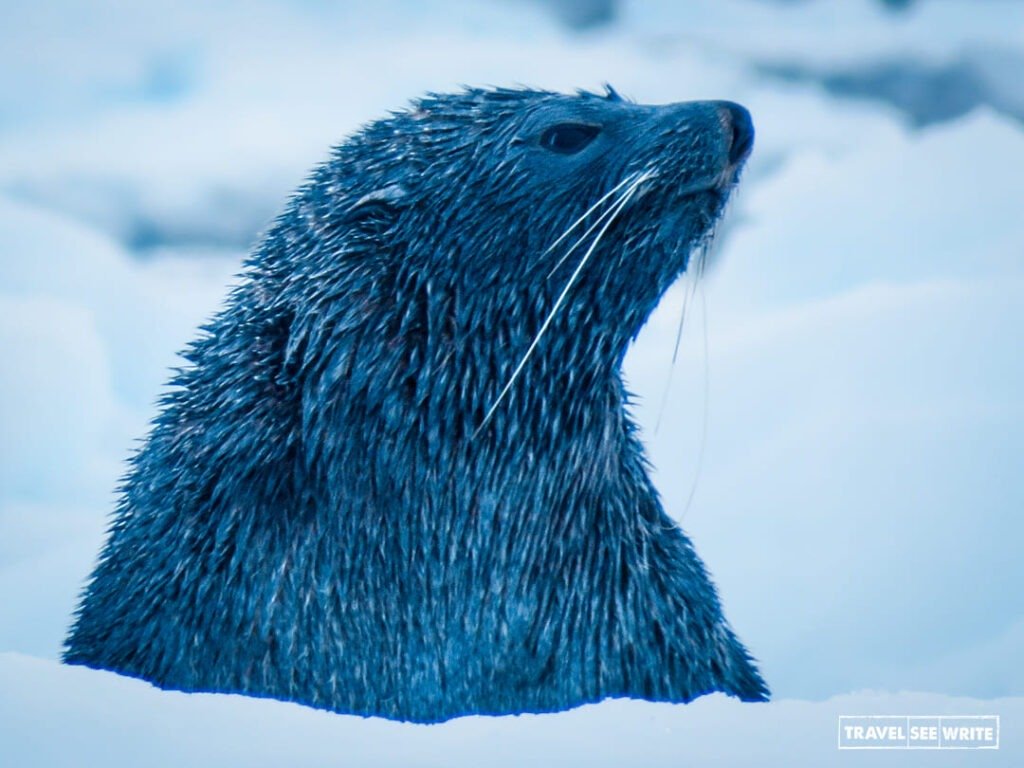
After lunch, we continued to Mikkelsen Harbour for our final landing of the trip. Mikkelsen Harbour is situated on the southern coast of Trinity Island at the northern End of the Palmer Archipelago. This region was first discovered during the Swedish Antarctic Expedition. The harbour was historically used by whalers to moor factory ships and is named after Norwegian whaling captain Klarius Mikkelsen. We found a large pile of whalebones on the island’s northeast shore alongside an old Whalers’ water boat. There was a large pile of whalebones alongside an old Whalers’ water boat buried in snow on D’Hainaut island’s northeast shore, where we made the zodiac landing.
As we hiked the D’Hainaut Island, we encountered a large colony of gentoo penguins and an Argentinian refuge hut. For more than an hour, we watched penguins interact at their nests. It was heart-melting to witness their playful scuffles and attempts to steal stones from one another. We also saw several Leopard Seals, Cape petrels, gulls, and their chicks and noted that a snowy sheathbill was feeding on the penguin droppings.
After a heavy heart, it was time to bid goodbye to these lovely creatures.
Day 9 & 10 – The Drake Passage Northbound
As we began our northbound crossing of the Drake Passage on November 22nd, I took advantage of the calmer waters to reflect and deepen my understanding of this extraordinary ecosystem. I attended numerous presentations:
- Greg Potter (Geologist & Glaciologist): “Antarctica’s Prehistoric Paradise”
- Nick Englemann (Marine Biologist): “Adapt or Die: How Life Adapts to Antarctica’s Extreme Environment.”
- Cory Jones (Ornithologist): “Seabird Threats and Hopes for the Future”
- Adrian Boule (Assistant Expedition Leader): “License to Krill”
- David Burton (Historian): “Melting Empires & Frozen Conflict: The Antarctic Treaty”
Day 11 – Disembarkation and Farewell
We enjoyed bridge tours, shared our photo journals, and even gathered for a movie matinee featuring “Happy Feet!” I loved the fundraising auction for Antarctic research, where priceless items such as a bottle filled with Antarctica water and an Antarctica flag signed by the Ship caption were auctioned. I wish I could have won something. Our trip culminated with Keith Thompson, the expedition photography guide, who shared the voyage slideshow and our Polar plunge pictures. For the entire hour, the clapping didn’t stop. The mix of fun and education was invigorating, culminating in a Captain’s Farewell Dinner and after-party dance filled with camaraderie and reflection.
November 24th arrived, and as I disembarked the ship back in Ushuaia, a wave of emotions washed over me. This journey had not just given me a glimpse into Antarctica’s wild, untamed beauty but also instilled within me a profound appreciation for the fragility of our planet.
With memories of curious Gentoo penguins, astounding icebergs, and the thrill of adventure etched in my heart, I returned home with a commitment to champion conservation and protect this incredible world for generations to come. Antarctica had shared its secrets, and I would always carry them with me.
Standout moments from my 11-day Antarctica Expedition
During our Antarctic expedition, we were fortunate to encounter an incredible array of wildlife. We spotted different types of penguins, Gentoo, Chinstrap, and Adélie, along with several species of birds and seals, including elephant and leopard seals. The highlight for me was the Gentoo penguins; they were particularly curious and often approached us quite closely, creating a delightful and memorable experience.
Crossing the Drake Passage was an adventure, with mixed excitement and trepidation among everyone aboard. The rough seas were challenging, but the informative knowledge-sharing sessions truly utilised this time well and connected us more deeply with the frozen continent. Also, I had the opportunity to bond with other guests and the expedition team during this time.
What impressed me the most was the expedition team’s commitment to employing strategies to promote sustainable tourism practices. They emphasised the importance of respecting the pristine environment, minimising our footprint, and educating us about the delicate ecosystem. This commitment to sustainability not only enhanced our experience but also left us with a deep appreciation for the need to protect such an extraordinary part of the world.
Activities during the Antarctica Expedition
During our 11 days on the World Explorer vessel, we had a variety of off-ship activities that made my polar experience truly memorable.
Zodiac Cruising
Every day, we would get into rugged inflatable watercraft that would take us to places our big ship couldn’t access, allowing us to reach remote shorelines, explore shallow inlets and search for unique wildlife. Most of the time, we would land on the islands to get up close to the polar wildlife. Other times, when it was not safe to land, we would go cruising around icebergs and glaciers.
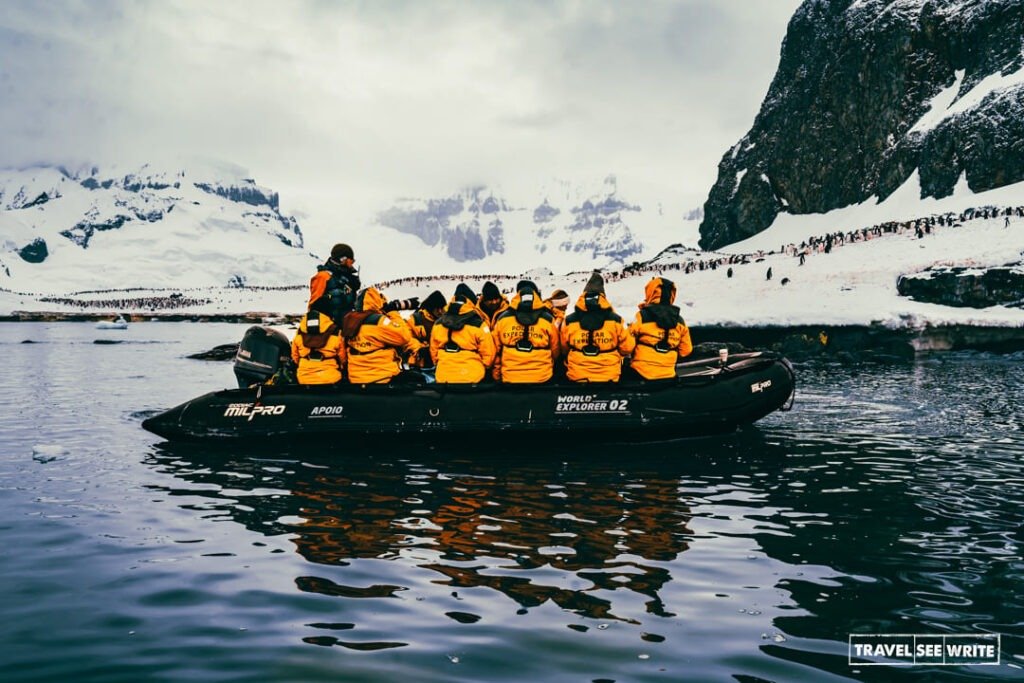
Landing and Hiking
We had both dry and wet landings, but Quark staff always ensured our safety. Hiking in Antarctica is free-form and was always supervised by Quark Expedition expert staff, who set out a perimeter or paths at each landing site within which we were free to explore. Additionally, Quark staff was always there to answer all our questions about the wildlife, history and geography of the area.
Polar Plunge
One of the most thrilling activities was the Polar Plunge in Antarctica, where 127 participants ranging in age from as young as 11 to as old as 75 jumped into the frigid waters of Antarctica, which were around -3 degrees Celsius. This provided an exhilarating experience for those brave enough to take the plunge! I am happy to say that after doing my Polar Plunge in the Arctic in September 2024, I was able to do it again, but this time, I was in Antarctica.
Additional Adventure Options
In addition to the above adventure activities and observing wildlife, several extra adventures were available for additional cost, such as Sea Kayaking, Paddle Excursions, Stand-Up Paddleboarding, and camping on the Antarctic ice.
Passengers on Board
You never know who you might meet on your ship or if you’ll connect with the group. Our ship hosted 157 guests from 24 nationalities, 108 crew members from 24 nationalities, and 26 members of the Quark Expedition team from 10 nationalities. Among the 157 guests, over 20 were earlier on an 18-day journey to the Falkland Islands, South Georgia, and Antarctica with Albatros Expeditions on the Ocean Victory vessel. Unfortunately, their adventure was abruptly cut short in the South Georgia Islands due to damage to their ship, forcing them to return to Ushuaia. Fortunately, they managed to secure a last-minute deal with Quark Expedition.
The average age of the guests was 45, with the oldest being 84 and the youngest 11. A group from China travelled with us. The rest consisted of couples, small groups of friends, and solo travellers from all age groups and around the globe. I met incredible people from everywhere. One person who left a lasting impression on me was Karla, a remarkable 75-year-old woman from the USA who travelled solo to Antarctica. Her enthusiasm was utterly infectious! She was always the first to seize any adventure, whether it was braving the icy waters for a polar plunge or lighting up the dance floor with her classic moves. Meeting her and the many other solo women travellers on the ship truly inspired me. I wish I could embody the same spirit and courage they displayed—it’s a reminder that age is merely a number when it comes to adventure!

Why Choose Quark Expeditions?
Moreover, the service aboard the World Explorer was akin to staying in a five-star hotel. With all-suite accommodations and exemplary food and service, comfort was guaranteed. Most importantly, safety was a top priority for Quark Expeditions, ensuring that we navigated the breathtaking wilderness with ease.
Having experienced both Arctic and Antarctic expeditions, I can wholeheartedly say that Quark Expeditions offers the most authentic and adventurous polar journeys. Their commitment to sustainable tourism and expert-led expeditions is evident in every aspect of the experience. It deepened my appreciation for the fragile polar regions and inspired me to advocate for sustainable travel in Antarctica.
While some may argue that all Antarctica expedition ships visit the same sites, Quark truly stands out due to its exceptional staff and facilities. My 11-day adventure was led by an incredibly experienced team, including the Expedition Leader Shane Evoy, who has dedicated 30 years to leading Antarctic trips. The Expedition Team at Quark is the best in the industry, bringing a wealth of knowledge in polar history, marine biology, glaciology, ornithology, and photography. Their passion made my journey richer and deepened my connection to this remarkable place.

About World Explorer Vessel by Quark Expeditions
The World Explorer ship, operated by Quark Expeditions, is genuinely a remarkable vessel crafted for those eager to explore the breathtaking polar regions, all while indulging in a world of comfort and luxury. Accommodating approximately 180 passengers, it provides a cosy and intimate atmosphere that’s a refreshing break from the crowds of larger cruise ships.
One of the ship’s most impressive features is its modern and chic design. With spacious cabins, many offering private balconies, guests can soak up the stunning views of the pristine, icy landscapes right from their own rooms. The well-appointed public spaces, including vibrant lounges and panoramic observation decks, create perfect settings for socialising and marvelling at the scenery.
Safety and adventure go hand in hand aboard the World Explorer, thanks to its ice-strengthened hull technology, designed to confidently navigate the icy waters of Antarctica and other polar destinations. Plus, the ship is equipped with cutting-edge expedition amenities, including zodiacs for seamless shore landings, a dedicated science center for engaging educational programs, and a wellness center for relaxation after a day of exploration.
Dining aboard is a true delight, with talented chefs crafting delicious meals catering to diverse dietary preferences. Imagine enjoying a gourmet meal while being surrounded by spectacular vistas—what an unforgettable experience!
With a strong commitment to sustainability and environmental responsibility, Quark Expeditions prioritises minimising the impact of its journeys on fragile ecosystems. Overall, the World Explorer harmoniously blends adventure and luxury, making it the perfect choice for travellers excited to uncover the extraordinary wonders of Antarctica and beyond!
Why Choose Adventure Life?
Adventure Life excels at understanding your specific needs and preferences. Its global partners bring a wealth of unique strengths, making it easy for them to craft a personalised itinerary just for you. They’ll be there for you every step of the journey—before, during, and after—providing peace of mind and support. Should any unexpected challenges arise, such as changes to your travel plans, you can rest easy knowing they are ready to assist.
Booking a trip to incredible destinations like Antarctica is an exhilarating opportunity. Anyone can book directly, but I highly recommend utilising a reputable travel agency such as Adventure Life. This type of adventure is truly a once-in-a-lifetime experience, and it’s essential to ensure everything goes smoothly.
Moreover, their services extend well beyond Antarctica. When I had an overnight layover in Buenos Aires, they arranged everything seamlessly—from accommodation to transportation. The quality of the hotel, local guide, and driver was outstanding. It’s impressive how they prioritise your comfort and experience.
How Much Does It Cost to Go to Antarctica?
If you’re planning a trip to Antarctica, one of the first questions you’ll likely ask is: what’s the cost of travelling to Antarctica from India? As outlined in many Antarctica travel guides, the expenses can vary greatly depending on the type of trip, month and activities you choose. While it’s possible to find budget-friendly options, the reality is that a very basic Antarctica trip can start at a minimum of $7,000 (with other operators, not Quark). For more comprehensive journeys that include destinations like the Falklands, South Georgia, and Antarctica, prices can soar to $50,000 or more. On average, be prepared to shell out $10,000 for a decent Antarctica trip. It’s worth noting that these estimates don’t include additional costs such as bigger cabins, helicopter service, extra activities, internet, flights, and other extras. If you’re looking for ways to travel to Antarctica for free, I’ve shared some insider tips and tricks in the Antarctica Travel Guide FAQs section below. However, for most travellers, it’s essential to be prepared for the significant expenses involved in exploring this incredible continent.
What to Pack for Antarctica
When venturing to Antarctica, it’s crucial to prioritize warm and waterproof clothing, as emphasized in the Antarctica Travel Guide. Dressing in layers is key, with essentials including:
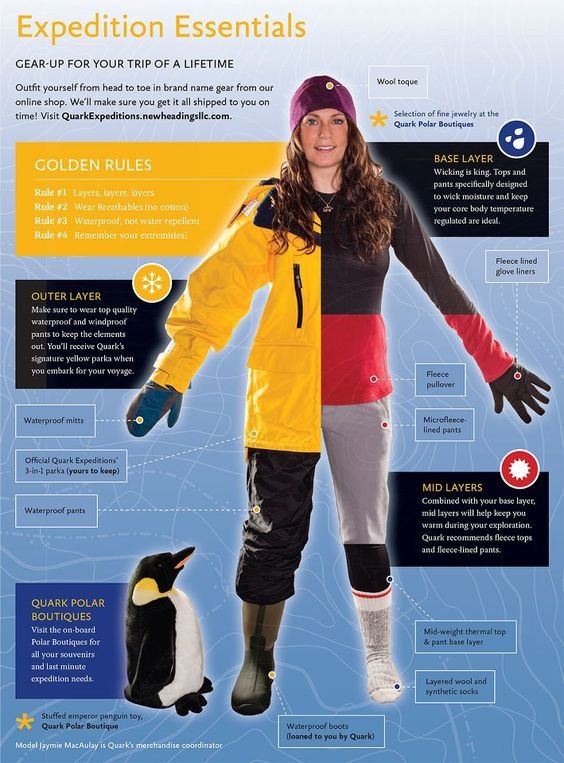
- Waterproof insulated ski pants like Columbia Bugaboo II Pants
- Inner thermals
- Base-layer wool or synthetic top and bottom
- Mid-layer fleece top and bottom
- Warm wool or synthetic socks (keep a dry pair in your bag, and bring extras for layering)
- Glove liners, Hand and feet warmers
- Waterproof gloves or mitts (bring 2-3 extra pairs)
- Scarf, buff, or other face protection
- Warm hat that covers ears (bring an extra)
- Polarized sunglasses with UV protection (consider bringing an eyewear retainer: string/clip etc.)
- Ski goggles (for Zodiac cruising on snowy or windy days)
- A swimsuit for polar plunge and spa
- A broad-spectrum sunscreen with at least 50 SPF
- Waterproof, lightweight backpack or dry sack and/or rain sleeve for camera or a waterproof phone case (to keep camera and gear dry)
- Don’t forget to include other must-haves like binoculars, a camera, a travel adapter, medications, and toiletries to ensure a comfortable and enjoyable journey.
- Comfortable casual clothing like lighter shirts, pants or jeans, etc. (in case the ship gets warm)
- Comfortable, non-slip closed-toed, heelless shoes (flip flops, sandals or slip-on shoes should not be worn on board due to safety concerns)
- Collapsible walking sticks for hikes (if required. They are provided by Quark as well)
- Sturdy waterproof boots for Ushuaia excursions
A Note on Sustainability
The expedition took climate change challenges very seriously, as Quark Expeditions emphasised the fragility of Antarctica throughout our journey. Even before our trip started, we were provided with detailed guidelines on how to travel sustainably to Antarctica through documents such as the IAATO Clean Seas Guidelines for Visitors and IAATO Guidelines for Visitors to the Antarctic document. Once on board, the expedition teams delivered several impactful presentations that highlighted environmental issues affecting the region. For example, we learned about the detrimental effects of krill farming on local wildlife, the historical impacts of whaling, and how changing weather patterns are influencing ice sheet stability. To ensure we contributed to preserving this pristine environment, Quark Expeditions implemented strict biosafety and safety measures. We were instructed to maintain a respectful distance from wildlife (15 m) to avoid disturbing their natural behaviours. The expedition also emphasised that our access to wildlife came secondary to their safety and well-being. This responsible approach educated us about the region’s challenges. It reinforced the importance of sustainable tourism practices in such a delicate ecosystem.
Antarctica Travel Tips: Frequently Asked Questions
- Best Time to Visit: The optimal time to explore Antarctica is the Austral summer, spanning from November to March when temperatures are more pleasant and daylight is extended. During this period, you can choose what interests you most: November is perfect for viewing penguins, plentiful sea ice, and penguin courtship; December and January are best for observing penguins hatching and their chicks; while February and March are prime for spotting humpback whales.
- Travel from India to Antarctica: I flew with Ethiopian Airlines from Delhi to Addis Ababa and then to Buenos Aires. From Buenos Aires, I took a connecting flight to Ushuaia. Alternatively, you could fly via Europe, the USA or other Asian airlines to Buenos Aires (Argentina) or Santiago (Chile). However, be prepared for a long and potentially tiring journey from India to Ushuaia. My entire journey took more than 36 hours, with an overnight layover in Buenos Aires. As mentioned in our Antarctica Travel Guide, it’s essential to plan your flights carefully to ensure a smooth journey.
- How to go to Antarctica for free: Antarctic expeditions are very special expeditions and are limited in number. Moreover, the journey from Ushuaia to the Antarctic Peninsula via Drake passage is treacherous and requires special skills. Therefore, the only way to visit this continent is to sign up with Antarctica Expedition companies like Quark Expedition. Unless you are part of the crew or a big content creator/journalist, it is impossible to travel to Antarctica for free. However, there are ways to get a good deal. You could save money if you book in advance, take advantage of special promotion days like the Black Friday Sale or simply use my special coupon code to get an additional discount.
- Is the Drake Passage Dangerous: While known for rough seas, modern ships like the World Explorer are well-equipped to handle the conditions but be prepared for potential seasickness. As mentioned in our Antarctica Travel Guide, it’s essential to choose a reputable tour operator that prioritizes safety and comfort.
- Booking with Adventure Life: Working with a reputable travel agency like Adventure Life can make booking more manageable and ensure you get the best possible deal. They specialise in adventure travel and can provide expert advice on choosing the proper expedition for you. For more information on booking your Antarctica trip, consult their Antarctica Travel Guide for tips and recommendations.
- Flight Considerations: Book flights in advance, especially during peak travel seasons. Consider utilising airline miles or travel points to reduce costs.
- Jet Lag: Consult your doctor about jet lag remedies and consider adjusting your sleep schedule a few days before your flight.
Concluding Thoughts
Antarctica is more than a destination; it’s a transformative journey. From the mesmerising landscapes to the profound connections formed with fellow travellers, this expedition has been a once-in-a-lifetime experience. Whether you’re drawn by the promise of wildlife encounters or the allure of untouched wilderness, Antarctica offers an adventure like no other. I hope this Antarctica Travel Guide has been helpful in answering some of your queries regarding the seventh continent. So what are you waiting for? Book your trip, pack your bags, prepare for the Drake, and embark on a journey to the 7th Continent—a place where every moment feels extraordinary.

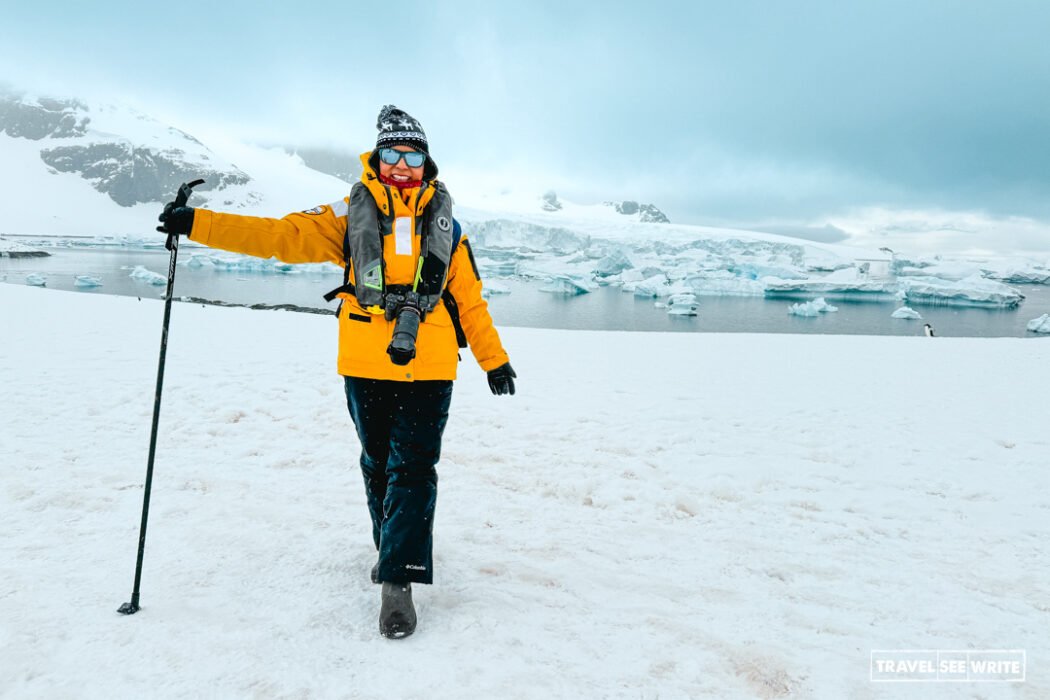
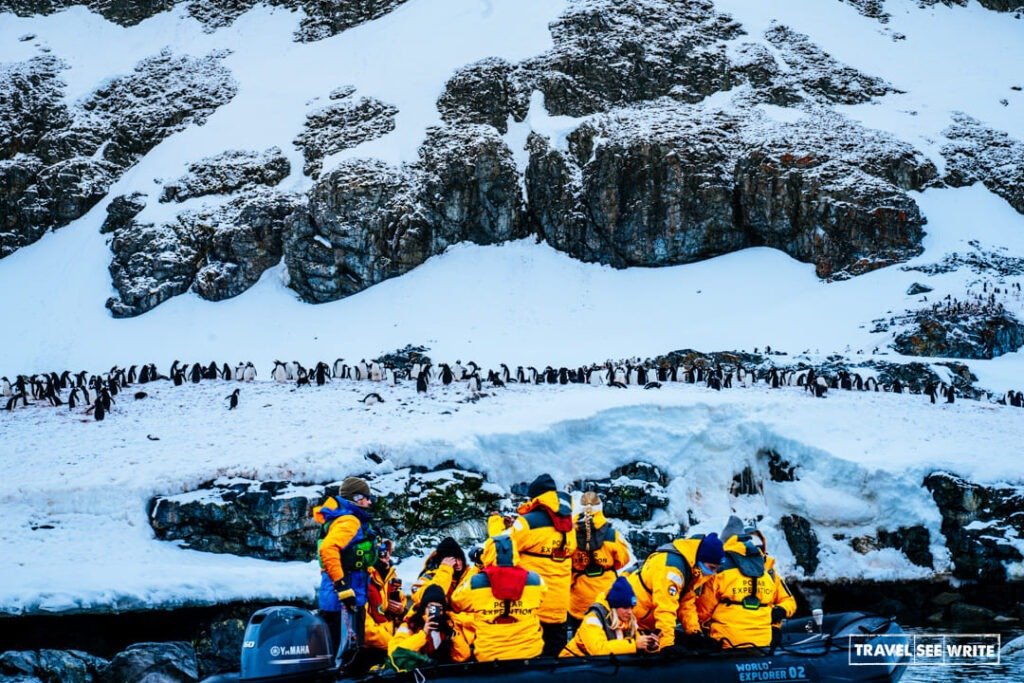
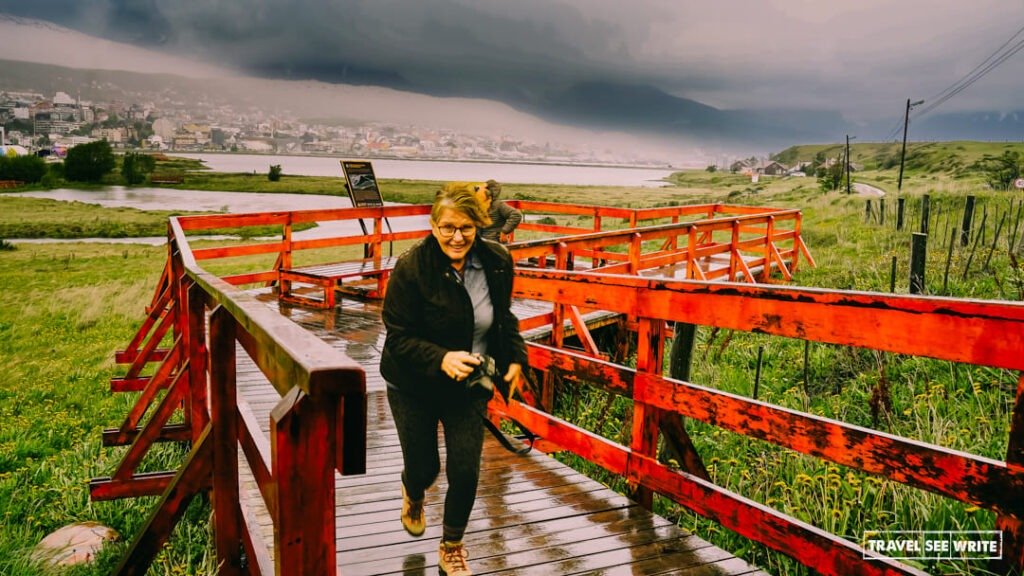
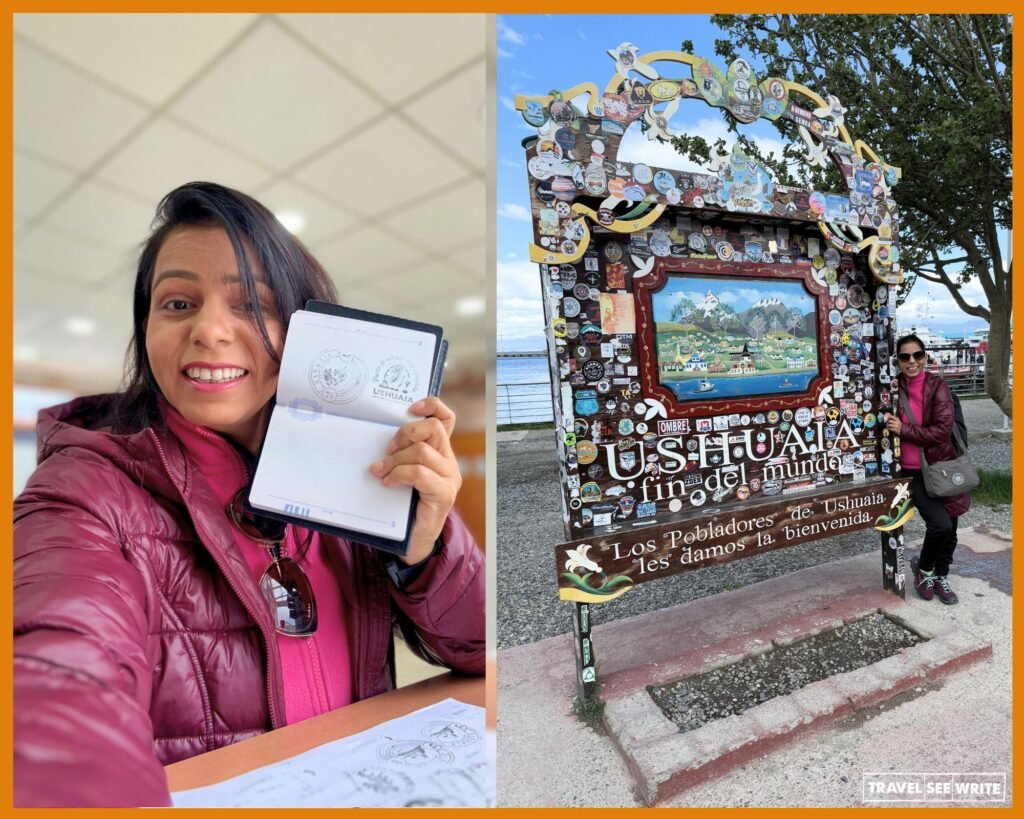
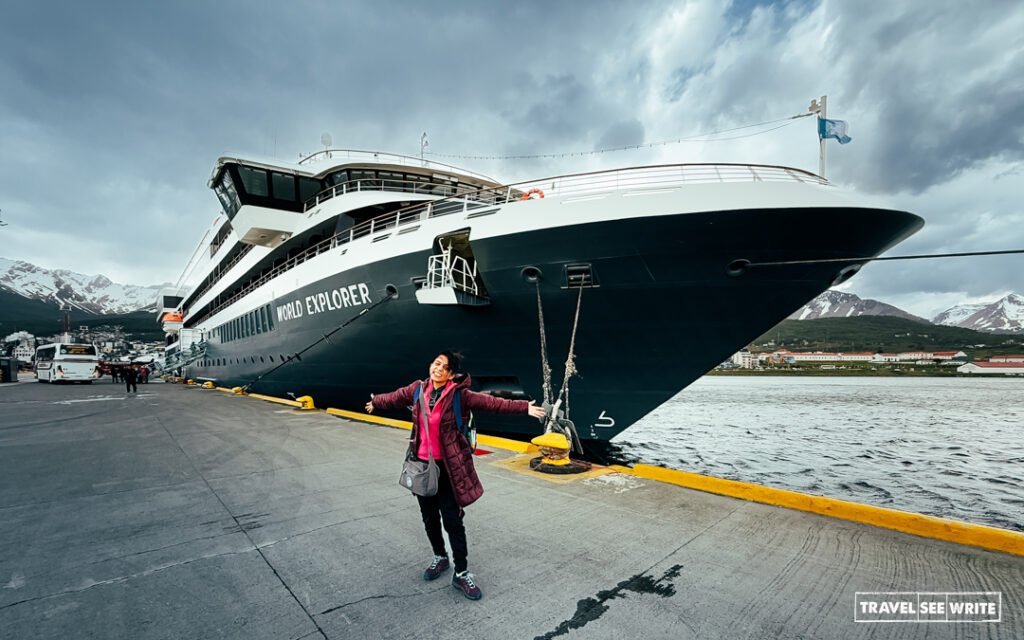

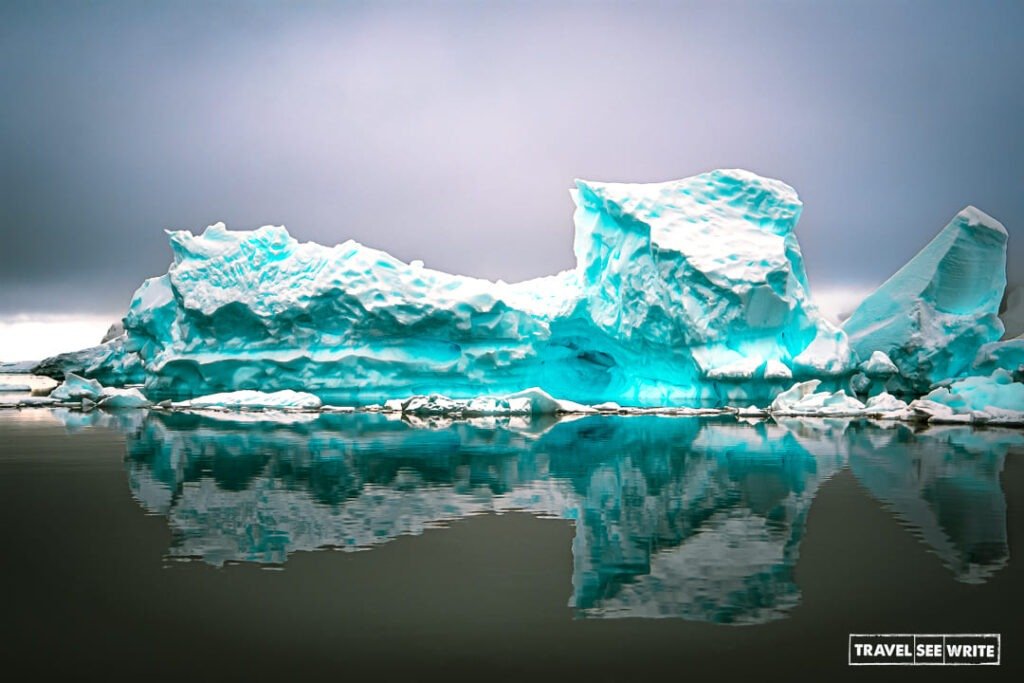
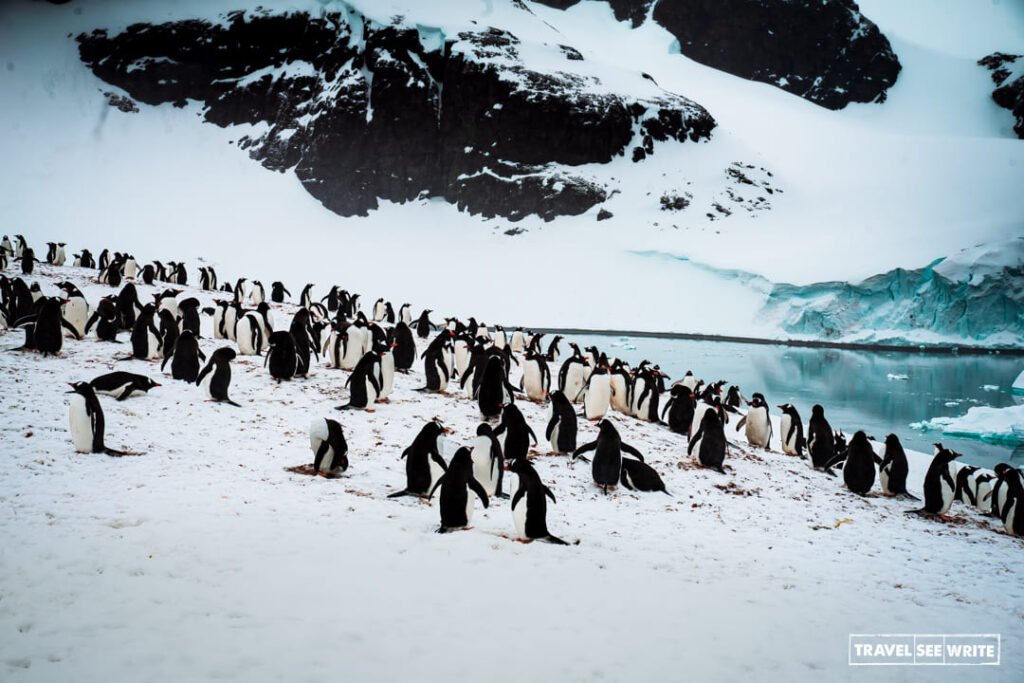
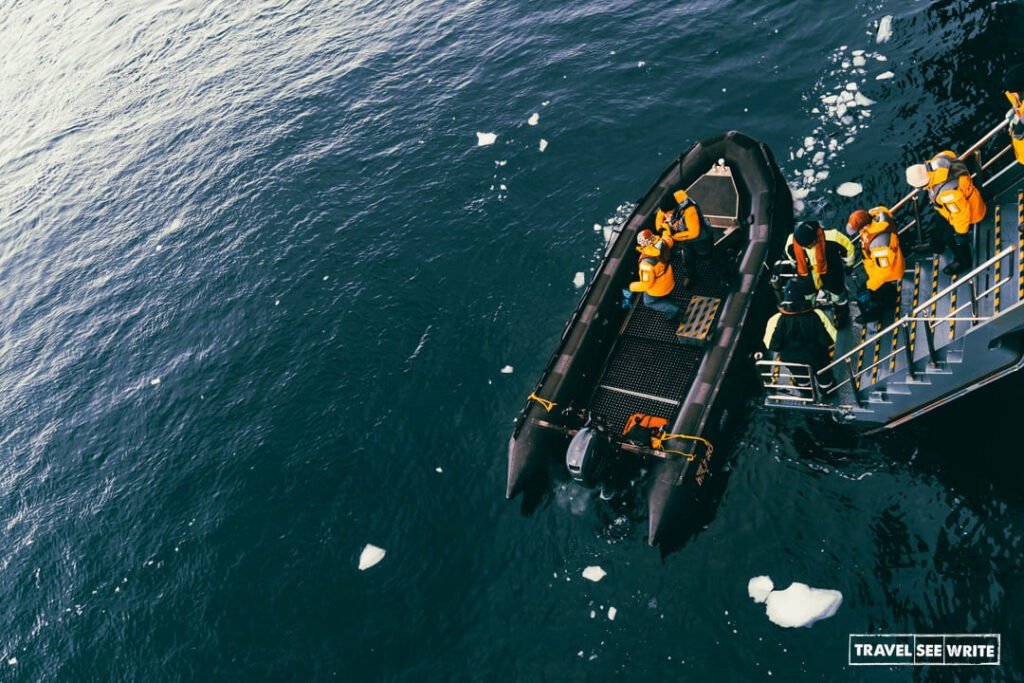
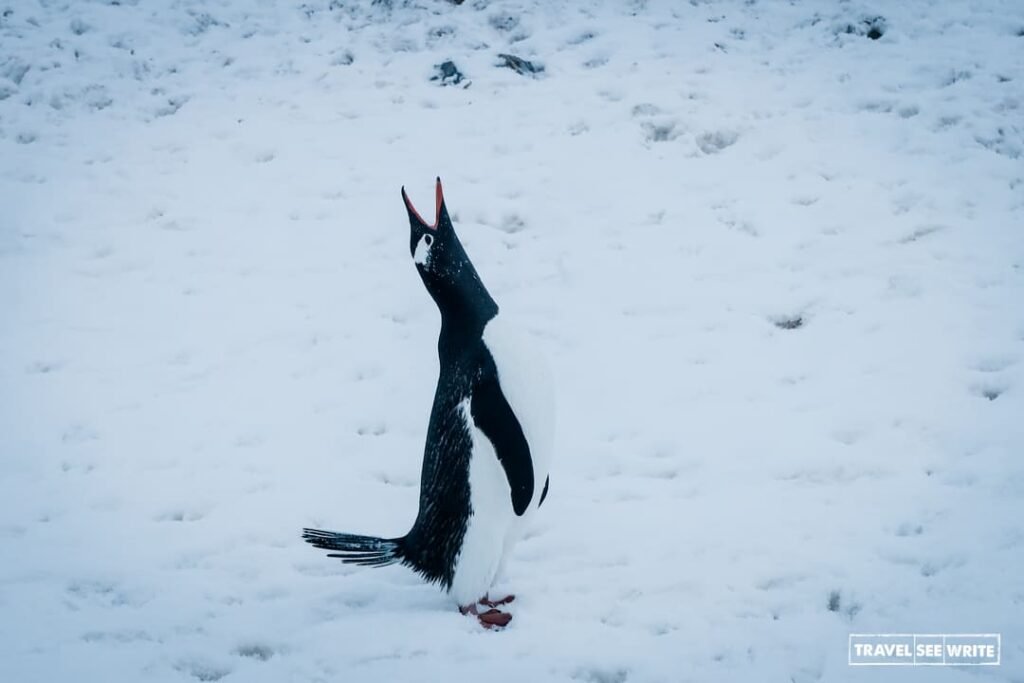
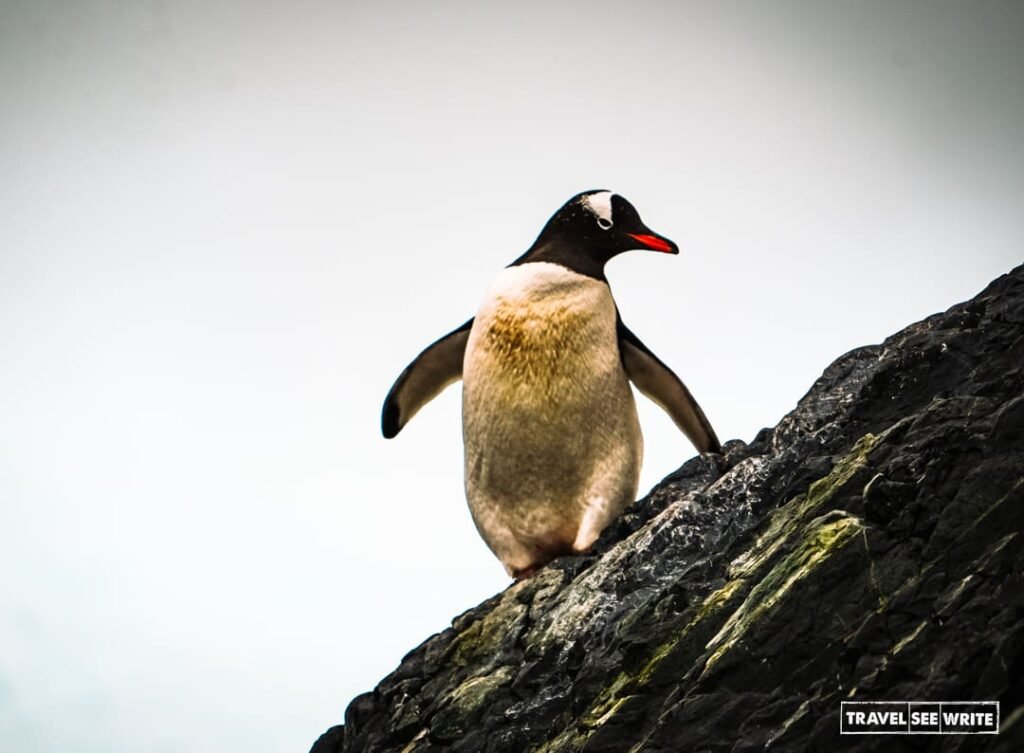
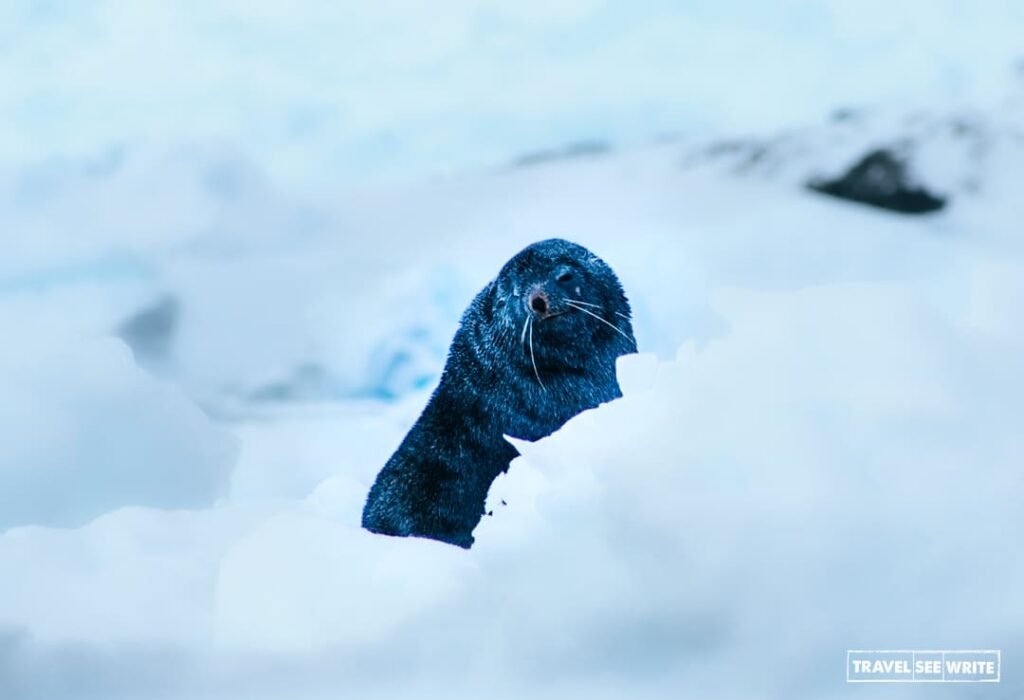
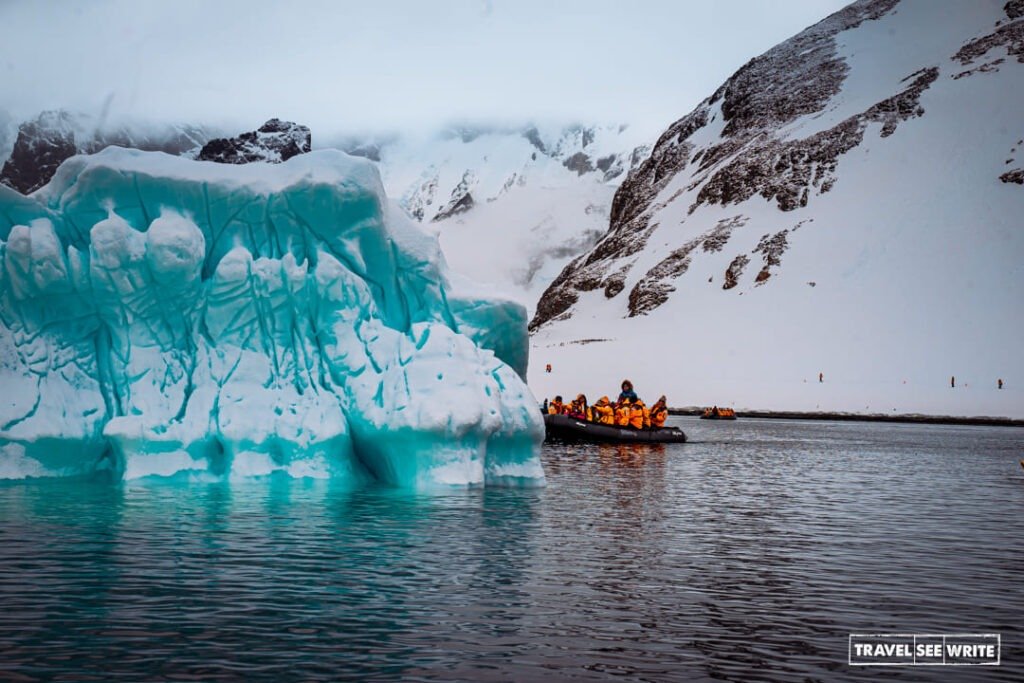

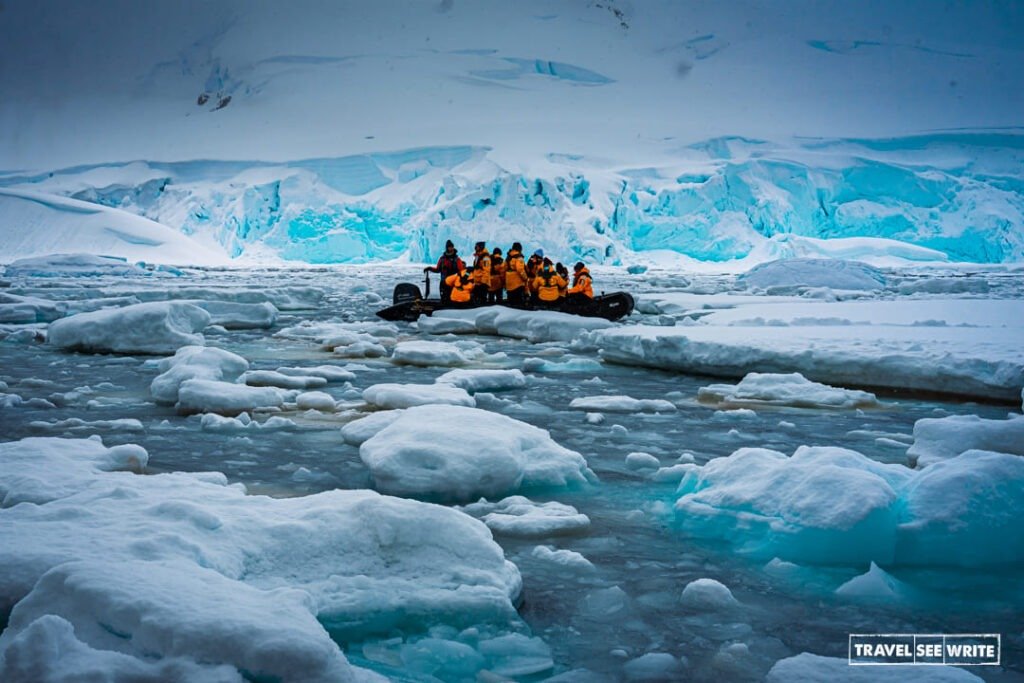

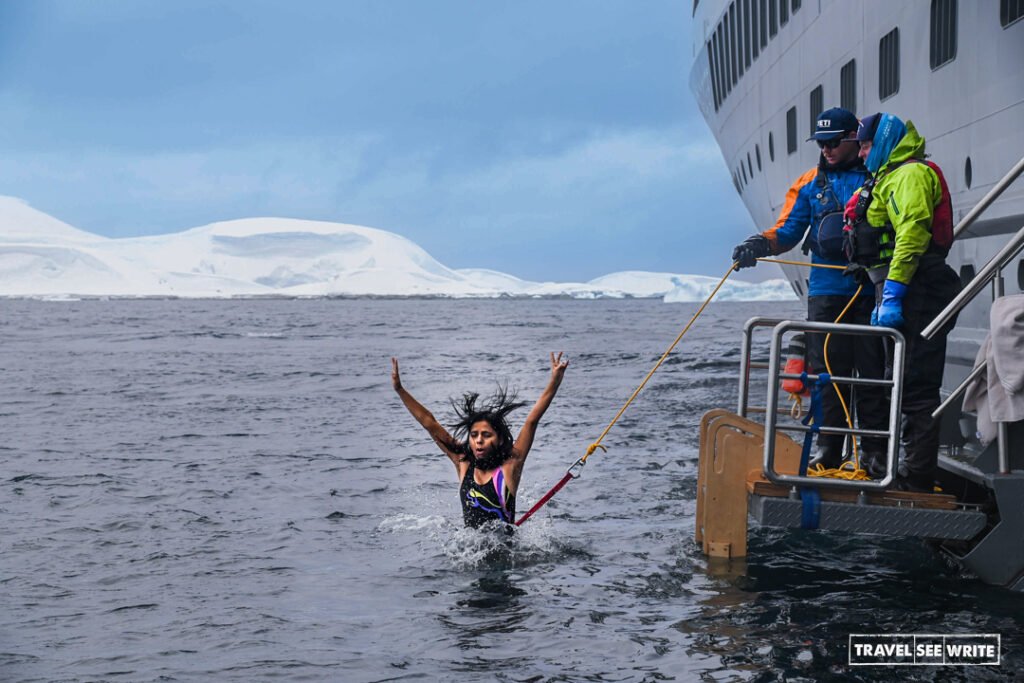
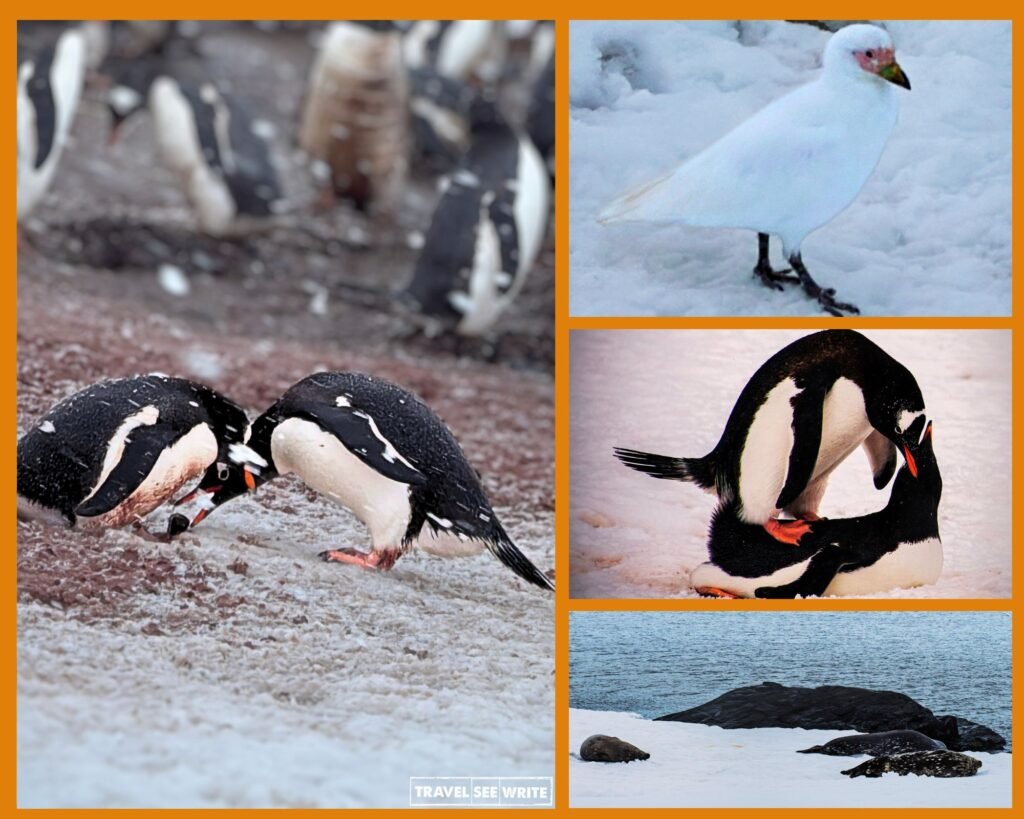
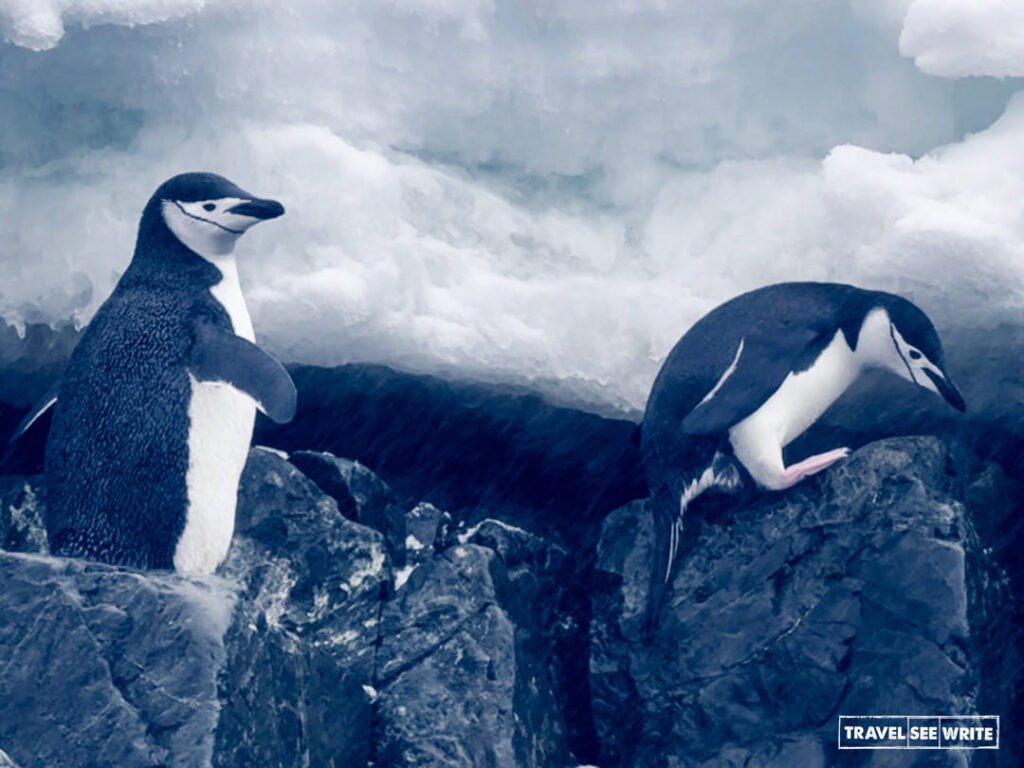
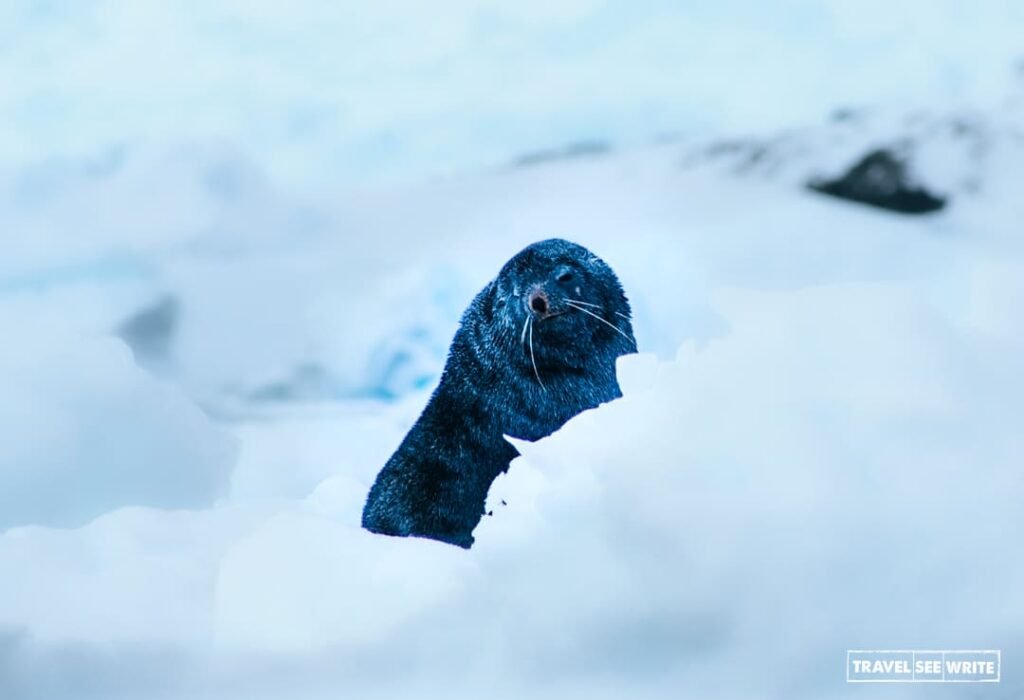
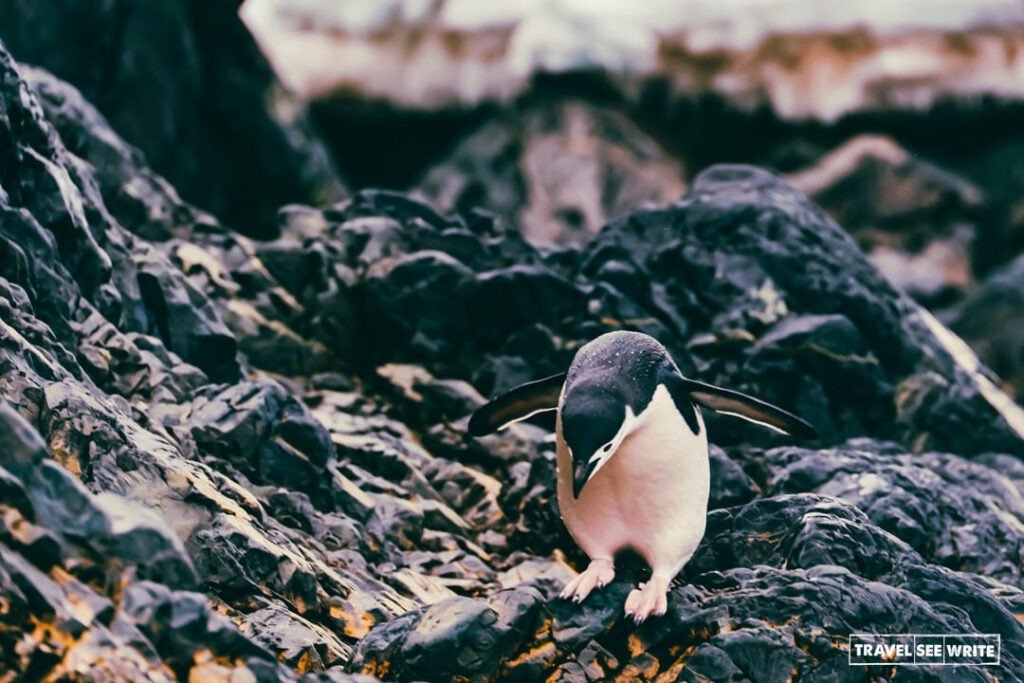

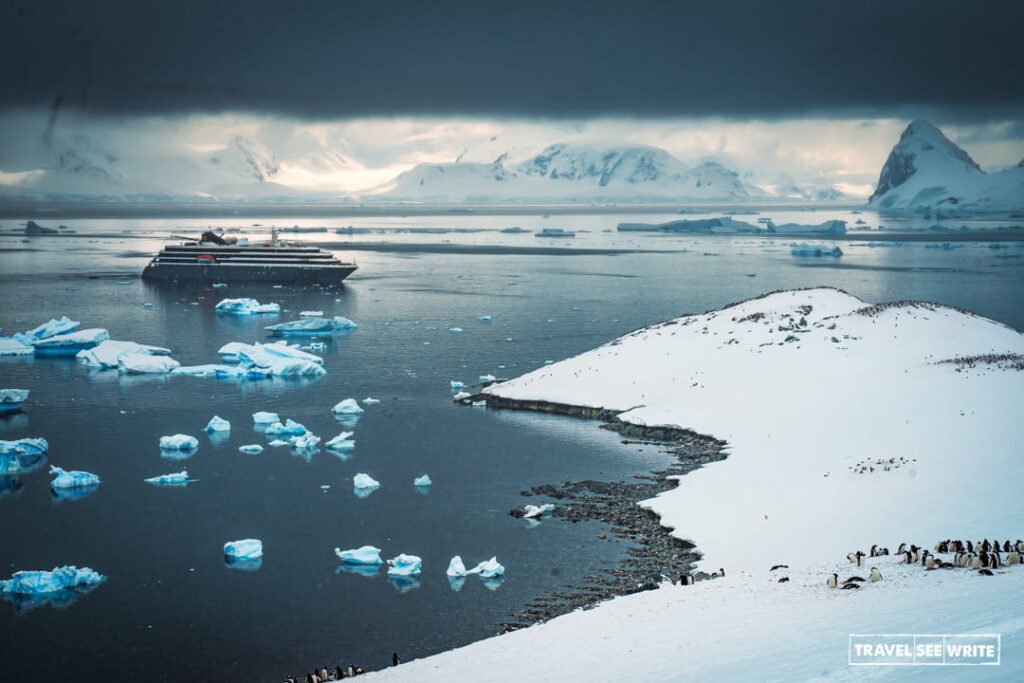



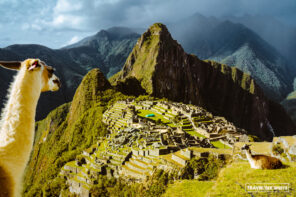

This sounds and looks like it was such an AMAZING trip and experience. I have to say I’m honestly jealous. I don’t know that I would have survived the sea sickness from the Drake Passage!!
You’ve managed to fit so much in. A great itinerary and information for those to plan a visit and make the most of it.
Your travels are amazing! This Antarctic expedition is something I never would have considered. But you have changed my mind! You look so warm, and those seal photos are so cute.
Thank you! A highly informative piece. I was transfixed as feel as though i was experiencing the Antarctica first hand. I have never been there but it’s now on list of places to visit!
I’ve always dreamed of partaking in an Antarctic Expedition and would love to set out and do so one of these days. I loved reading about your experience doing this…now I want to go even more!
wow, such amazing travels! I have never been to Antarctica but it sounds like an interesting place to visit
i can’t believe it. i had no idea you could actually visit Antarctica. i thought it was only for special explorers. so cool but must be FREEZING.
This is a real bucketlist experience! Going to antarctica seems like such an amazing adventure.
oh wow, this is definitely the experience of a lifetime!!! I would love to do that for sure…Just amazing…
Antartica has been on our must travel list for forever! Your incredible and detailed account of your Antarctica journey was so inspirational! I feel inspired to add this transformative experience to my 2025 travel list!
This guide is incredible—so detailed and full of practical tips for such a dream destination! Your insights into the costs and experiences make planning a trip to Antarctica feel much more approachable. 😊
Antarctica is such an interesting place to travel to and venture. It looks like a lot of fun, would love to visit one day.
Antarctic expedition in itself an unforgetable experience in my opinion. Thanks for the tips on making it even more special!
Antarctica is such a unique destination. It’s interesting to see detailed tips on how to make the most of a trip there. Definitely a bucket list spot.
I don’t think I will ever make it to Antarctica so I can live vicariously through your guide! You have included so many helpful tips and I appreciate the budget tips too, I know it’s expensive to visit there.
Oh, wow! I actually had no idea there was so much adventure in Antarctica. You hear that name, and imagine nothing but ice and sky.
All I can say is I am very jealous, despite the cold this is a dream of mine and something I would love to experience
This is the ultimate bucket list destination and it sounds like an amazing trip. I’m so glad that you were able to tick this continent off your bucket list and experience it x
Oh wow, that must have been such an amazing experience. It sounds like you managed to see quite a bit on your visit. It’s great to be able to see these places in person rather than on the tv or in books.
Antarctica sounds like an interesting place to visit. I’ve never considered it, though. Cold!
This sounds like an absolutely wonderful adventure. How cool that you traveled to Antarctica to see the sights. This would be a bucket list trip for sure! The tour sounds like an excellent choice. I love your pictures of the penguins and the scenery.
Wow, what an adventure indeed. You are so lucky to experience what most people dream off and I am so glad you have documented it as well, so we can follow your journey and discover more about the Antarctica
I’ve seen great photos and read great experiences of people who visited Antarctica. Your experience is amazing. I would like to visit someday.
wow this looks absolutely amazing. It’s definitely a bucket list experience I didn’t even know I needed
I would love to do something like this but I am a hot girl through and through , 35 degrees and I’m in my glory ! 🙂
Sounds like Antartica is a great place for an adventure, thanks for the tips.
Antartica sounds so much fun. I would love to visit there sometime. I loved reading your experience over there.
Wow! Talk about a dream trip! Incredible!